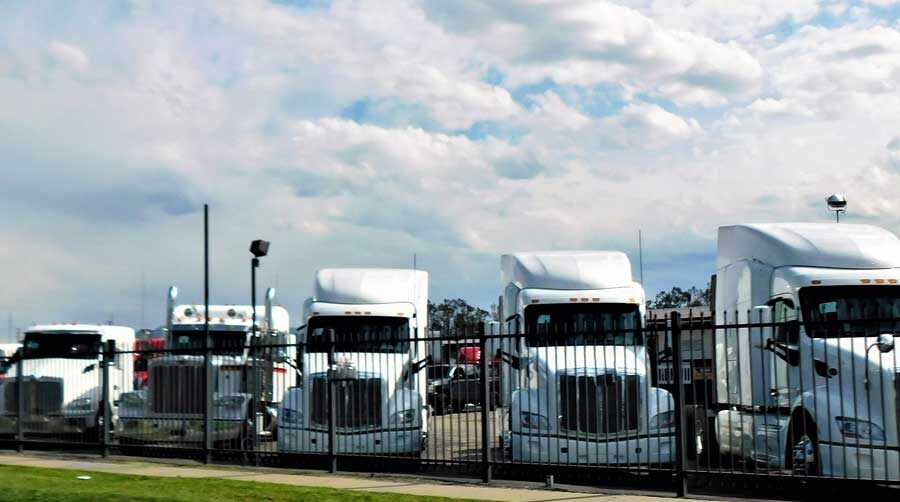Key Takeaways:
- Consistency is important for maintaining accurate Driver Logs and guaranteeing HOS compliance with federal regulations.
- Incorrect time zone logging can result in HOS compliance violations, fines, inspection delays, and safety rating reductions for fleets.
- Manual adjustments are often necessary. Logging annotations can clarify any time-related discrepancies during changing time zones with ELD.
- Effective training on time zone rules and device settings for both drivers and fleet supervisors is also important for guaranteeing HOS compliance.
- Fleet managers must set default time zones correctly, provide comprehensive training, and diligently monitor driver logs for any time-related discrepancies.
Table of Contents
Mastering ELD Time Zone Settings to Improve HOS Compliance and Accuracy
A long-haul driver starts a shift in Arizona, crosses into New Mexico, and ends the route in Texas. Discrepancies appear in the driver logs, leading to questions about HOS compliance. Confusion often arises from driving hours and from inconsistent ELD time zone logging.
HOS compliance depends on accurate time recording. Each minute logged must reflect the correct ELD time zone. Mistakes lead to audits, fines, and safety risks. Fleet operations lose efficiency without consistency in timekeeping. Drivers, fleet supervisors, and compliance officers must all understand time zone rules.
Every Electronic Logging Device relies on system time settings. These settings determine how driver logs record activity. The ELD time zone setting controls all entries, even during changing time zones with ELD. Understanding how devices apply time zone adjustments reduces errors and increases ELD accuracy.
This article clarifies the rules behind ELD time zone configurations, including ELD time zones and hours of service. The following sections break down the differences between UTC time and Local time, explain ELD time zone settings, and show how to avoid time zone errors with ELD. Readers will gain actionable steps that improve logging practices across all fleets.

The Fundamental Rule of Local Time vs. UTC Time
Local time refers to the standard time in the driver’s operating region. Every jurisdiction maintains distinct time zone rules, which require precise logging to attain HOS compliance requirements. A driver must reference the correct ELD time zone assigned at the fleet’s main terminal.
UTC time represents Coordinated Universal Time. Devices use UTC time internally. The system records logs based on this global reference. This universal standard creates a foundation for data accuracy, audit validation, and multi-region tracking. The ELD system converts UTC time into readable local time. Each log entry reflects the set ELD time zone, which stays consistent across routes. Time recorded in Texas must reflect the terminal’s zone, not the one temporarily entered.
Devices display time through ELD time zone settings configured during installation. These settings must match the fleet’s designated base of operations. Errors occur during changing time zones with ELD, especially during cross-border hauls. Incorrect displays result in log conflicts. The core disconnect happens between the device’s internal time tracking and the driver’s perception of local time. Errors appear where ELD accuracy breaks down due to manual overrides or incorrect Time zone adjustments.
Fleet managers must apply consistent ELD time zone settings. Each change introduces risk. Drivers should verify the displayed time aligns with the terminal’s zone. Monitoring Driver Logs daily guarantees reliable records and avoids violations. Misalignment between actual driving time and recorded time leads to violations. Drivers must treat the ELD Time Zone as fixed, regardless of physical location. Time consistency supports audit transparency and maintains full HOS compliance.
Manual edits within ELD systems must follow the terminal-assigned time zone. Technicians and fleet supervisors must review Driver Logs with awareness of ELD time zone settings. Any mismatch between terminal time and recorded time signals system errors or incorrect configuration. Accurate logging requires proactive verification by drivers and fleet teams. Each trip must begin with confirmation of the active ELD Time Zone. A single overlooked detail can disrupt the integrity of HOS Compliance and trigger review from regulatory agencies.
Driver training must include specific instruction on handling time across state lines. Cross-regional travel demands awareness of both UTC time and Local time. Drivers must trust the system display and avoid adjusting clocks manually during shifts.
Systems with GPS integration automatically maintain correct time references. These integrations prioritize ELD accuracy, especially during changing time zones with ELD. Fleet managers must evaluate technology regularly and confirm proper synchronization. Accurate time zone setup prevents false violation flags. Incorrect entries result in gaps or overlaps within driver logs, which delay operations and increase inspection risk. Clear policies and digital oversight improve compliance.
Internal audits must occur on a recurring basis. Fleets that verify logs weekly detect time-related errors early. Review cycles protect against larger violations and reduce liability. Clear communication between dispatchers and drivers improves understanding of time zone requirements. Dispatchers must relay all instructions using the terminal’s ELD Time Zone. Miscommunication creates confusion that leads to non-compliance.
Understanding Federal Regulations on Time Zone Logging
Federal regulations require strict adherence to time zone rules within all logging systems. The Federal Motor Carrier Safety Administration (FMCSA) outlines clear directives for carriers and drivers. Each driver must record duty status according to the ELD time zone assigned to the home terminal. All records must follow this designated time reference without alteration across state or regional shifts.
The FMCSA enforces the “point of origin” standard. Each driver’s record must begin with the time zone of the carrier’s principal place of business. That zone becomes the sole reference point for HOS compliance throughout the 24-hour cycle. Records must reflect this zone consistently, regardless of physical location.
All logs must remain in a single time standard throughout the operational day. This uniformity reduces confusion and guarantees consistent driver logs across all jurisdictions. Carriers must align system settings to match this legal standard. Devices must also maintain these parameters across internal clocks and user interfaces.
The FMCSA permits few exceptions. Special temporary exemptions may occur under rare fleet-specific conditions. These conditions require official approval and documented justification. Carriers must retain all evidence of such exemptions for compliance audits.
Incorrect time zone logging creates serious consequences. Logs misaligned with time zone rules trigger immediate HOS compliance violations. Auditors identify errors based on time mismatches between records and GPS-tracked movement. Fleets risk fines, inspection delays, and safety rating reductions from these discrepancies.
Drivers must maintain awareness of their assigned ELD Time Zone at all times. Carriers should document standard procedures and educate drivers on compliant timekeeping. Operational consistency within these rules guarantees both audit readiness and legal integrity.

Changing Time Zones with Your ELD Step-by-Step Guidance
Many ELDs feature internal systems designed to adjust automatically during route changes. These automated updates align internal clocks with UTC time while displaying local time as configured. Not all devices execute these adjustments consistently. Drivers must remain vigilant regarding each change in displayed time.
Manual settings remain necessary for most units. Drivers must take responsibility for verifying ELD time zone settings at the start of every duty period. Any manual override must follow the assigned terminal time zone, not the physical location of the driver. Correct input protects against noncompliant driver logs and inaccurate records.
Accessing these settings varies by device. Most ELDs contain a “settings” or “system configuration” screen. Drivers must locate the ELD Time Zone input and confirm the value matches the home terminal. Fleet administrators should provide written reference material showing this step-by-step process.
Verification remains the driver’s duty. Each change in geographic region must prompt a check of the ELD time zone settings. Drivers must log their status with the proper time value throughout all stages of transport. Wrong entries contribute to gaps in HOS Compliance and audit complications.
Logging annotations create clarity. Drivers must mark log entries with time-related clarifications during changing time zones with ELD. These notes validate the intention behind adjustments and reduce disputes during inspections. Consistent annotations strengthen compliance credibility.
Fleet managers must audit these entries. Internal reviews should include routine checks of time zone adjustments across all units. Daily oversight guarantees strong operational records and prevents recordkeeping violations.
How to Avoid Time Zone Errors with Your ELD Practical Tips
Trip planning requires foresight regarding time zone rules. Route analysis must include identification of regions with different time references. Drivers must remain aware of upcoming shifts during cross-country trips. Advance knowledge reduces the risk of incorrect timestamps.
Dispatch teams must maintain clear communication standards. Every dispatch update must include information about expected ELD Time Zone alignment. Drivers benefit from reminders tied to state or terminal-specific requirements. Accuracy in these exchanges supports reliable driver logs.
Some ELDs include preview functions which display future time zone shifts based on GPS tracking. Drivers can use these tools to review upcoming changes. Review sessions at rest stops or terminals improve situational awareness. Previews reduce the likelihood of logging under the wrong zone.
Routine checks improve recordkeeping. Drivers must consistently monitor the displayed ELD Time Zone throughout the shift. Any unexpected deviation must prompt a system check or annotation. Persistent awareness reinforces strong HOS Compliance.
Effective training builds competence. Drivers and fleet supervisors must undergo instruction focused on how to avoid time zone errors with ELD. Sessions must cover device settings, verification steps, and legal obligations. Ongoing education prevents compliance gaps during high-volume operations.
Resources must include visual guides and quick-reference charts. Instructional material should remain accessible inside vehicles or digital fleet systems. Proper documentation builds confidence and reduces logging uncertainty. Operational consistency depends on technical knowledge and proactive behavior.
The Impact of Incorrect Time Zones on HOS Calculations
Incorrect ELD time zone records distort drive-time calculations. Logged hours may appear longer or shorter than actual operation. Errors often lead to drivers exceeding their legal driving limits. Fleet safety ratings suffer under repeated HOS compliance failures.
Rest periods depend on precise time tracking. Time zone mismatches shorten or extend off-duty intervals without driver awareness. Violations related to insufficient rest often trace back to timestamp inaccuracies. Accurate zones guarantee lawful break durations.
Auditors identify false log entries during inspections. Time discrepancies result in log violations even if drive time followed FMCSA limits. Violations stemming from Time Zone Rules errors create avoidable risks for carriers. Each instance invites penalties and questions about fleet oversight.
Device precision supports full ELD accuracy and every log entry must reflect the correct time reference without manual override mistakes. Reliable systems protect both drivers and managers from compliance disputes. Accurate logs build operational transparency and long-term accountability.
Fleet supervisors must review logs for time zone coherence. Internal reviews identify pattern-based mistakes across driver behavior. Corrective action begins with clear records and accurate Driver Logs. Strong oversight practices support carrier safety standards and prevent regulatory exposure.

Fleet Manager Responsibilities for ELD Time Zone Management
Setting Default Time Zones
Fleet managers must assign a default time zone for each vehicle during initial setup. The default Time Zone must align with the geographic location of the vehicle’s home terminal. Assignment consistency promotes accuracy across all Driver Logs. Each assignment must follow FMCSA regulations regarding Time Zone Rules.
Training and Guidance
Each fleet must provide structured training to all drivers. Instruction must prioritize clarity regarding ELD time zone entries and responsibilities. Training must include information about time zone rules, log adjustments, and boundary crossings. Printed guides and hands-on demonstrations improve learning retention among drivers.
Supervisors must offer continuous guidance through digital tools and policy updates. Communication channels must stay open between drivers and managers. Updated resources must reflect recent regulation changes and product feature updates. Knowledge reinforcement improves compliance across teams of all sizes.
Monitoring Driver Logs for Errors
Fleet managers must review driver logs daily. Time stamp checks must occur during every log inspection cycle. Spotting incorrect Time Zone entries requires familiarity with route schedules and boundary crossings. Managers must highlight suspicious entries which do not align with expected shifts.
Reviews must occur using time-based filters within ELD management platforms. Log discrepancies often appear during trips involving cross-region travel. Entries which show time mismatches or overlap must receive manual follow-up. Drivers must submit explanations through annotations within the ELD interface.
Implementing Clear Policies
Clear internal policies provide a framework for accountability. Written rules must define expectations for ELD Time Zone accuracy and update responsibilities. Company procedures must include correction workflows for errors identified during audits. Thoroughly documented processes improve consistency across multiple terminals or hubs.
Policy documents must outline disciplinary measures for repeated violations. Documentation must identify responsible parties for each type of error. Drivers must acknowledge policy terms in writing before assignment. Formal procedures build a culture of ownership and compliance.
Utilizing ELD Management Systems
Fleet-wide ELD Management systems support broad oversight functions. These platforms track changes to Time Zone settings over time. Managers use historical logs to detect patterns or flag high-risk behaviors. Alerts within these platforms notify teams when device settings change unexpectedly.
Data visualization dashboards support bulk comparisons across drivers. Managers can compare logs across vehicle groups or time periods. Time zone filters identify where errors cluster geographically. Actionable insights lead to targeted interventions at specific locations.
Integration between ELD Management systems and HR platforms improves enforcement. These integrations allow automated assignment of training modules based on error trends. Managers receive status reports tied to learning progress and test completion. Accountability extends beyond initial instruction into daily performance metrics.
Systematic planning guarantees better results across fleets. Management teams must view time zone compliance as a shared responsibility. Strong digital infrastructure supports proactive monitoring. Success begins with well-defined rules and effective oversight methods.
Real-World Scenarios and Examples
Understanding how to apply Time Zone Rules in real-world scenarios is important for maintaining compliance with ELD regulations. Drivers encounter various challenges when crossing Time Zone boundaries, whether during long-haul trips, team driving, or short-haul operations. These situations require consistent application of rules to avoid errors in Hours of Service (HOS) logging and to guarantee accurate records during audits. These scenarios highlight the importance of consistent ELD time zone settings and the role of communication in overcoming potential discrepancies.

Long-Haul Solo Driver Crossing Time Zones
A solo driver begins the day at 6:00 AM in New York. The ELD Time Zone must reflect Eastern Time from the moment of login. The driver crosses into Central Time three hours later. The log remains in Eastern Time throughout the duty cycle. The FMCSA mandates a single Time Zone per 24-hour log cycle. No manual changes are required until the following day. Annotations may assist with explaining discrepancies during review. This situation demonstrates the correct application of Time Zone Rules across long-haul operations.
Team Drivers Operating Across Multiple Time Zones
Two drivers operate under a team driving schedule. The vehicle departs from Denver and crosses multiple regions in one shift. Each driver follows a consistent ELD Time Zone, which reflects the vehicle’s starting terminal. Device settings remain static throughout the shift. Team drivers communicate clearly before switching roles. Logs include annotations whenever boundary crossings create confusion. Misalignment between shifts increases the risk of record-keeping errors. Proper training prepares drivers to handle rapid changing time zones with ELD.
Short-Haul Driver Near Time Zone Boundaries
A short-haul driver operates within 20 miles of a Time Zone boundary. Daily trips sometimes begin in one zone and end in another. The ELD Time Zone remains aligned with the home terminal throughout the day. The FMCSA does not require mid-day changes for short-distance shifts. Managers remind drivers to ignore real-time local clocks, which differ from the log. Confusion often arises in regions near Time Zone divides. Regular reminders and log reviews prevent accidental adjustments. The scenario reinforces the need for steady compliance with Time Zone Rules.
Drivers Crossing into Canada or Mexico
When driving across borders into Canada or Mexico, Time Zone considerations become complex. A driver traveling from the U.S. to Canada follows the same principle: the ELD Time Zone reflects the home terminal’s Time Zone at the start of the duty cycle. Even with a country change, the log remains under the U.S. time zone setting until the next cycle begins. This scenario shows that borders do not immediately require Time Zone shifts during the driver’s shift, reaffirming the importance of consistency across international travel.
Cross-Country Operations with Multiple Time Zones
Drivers operating cross-country account for time zone shifts over longer distances. A route spanning from the East Coast to the West Coast involves crossing four distinct Time Zones. In these cases, the ELD time zone setting remains constant for the duration of the driver’s shift. The driver logs time using the original starting time zone, following the FMCSA’s mandate to avoid discrepancies. Frequent checks during long-haul operations guarantee no errors, keeping compliance intact across numerous Time Zone boundaries.
Shifting from Day Shift to Night Shift Across Time Zones
A driver working a night shift may encounter multiple time zones during the duty cycle. For example, the driver starts in Pacific Time, continues the shift into Mountain Time, and finishes in Central Time. The driver remains within the same 24-hour duty cycle. The ELD Time Zone remains static as per the regulations. The driver must follow this rule carefully to avoid HOS violations, especially when crossing multiple time zones in a short period. Annotations clarify any confusion during review, demonstrating compliance with time zone rules.
Night-Time Border Crossing Challenges
Some drivers face difficulties crossing borders at night, especially when routes involve complex time zone boundaries. The local time may differ from the ELD Time Zone setting, creating confusion when calculating hours of service (HOS) or rest periods at night. Night-time border crossings demand close monitoring. Drivers avoid adjusting their time zone manually unless required the following day. Regular communication with fleet management helps eliminate potential issues arising from these crossings.
Final Considerations for Operational Consistency
Drivers rely on guidance, not assumptions. Real-world challenges demand clear procedures. Logs reflect consistency, not local variance. Proper use of ELD Time Zone settings prevents misunderstandings during audits and inspections. Strong processes support accuracy across all routes and driver types.

Troubleshooting Common Time Zone Issues
Incorrect ELD time zone display often happens due to misconfigurations, software glitches, or hardware malfunctions. One common issue is when the ELD fails to detect a Time Zone change after crossing state or regional boundaries. Human error may also cause problems, such as forgetting to manually adjust the time zone setting. These issues require a thorough inspection of the settings and sometimes the application of software updates.
Adjusting time zone settings is typically simple, but some drivers may experience difficulty. To resolve this, accessing the device’s settings menu is necessary. From there, users can modify the Time Zone. If manual adjustments do not solve the problem, restoring default settings may help. After making changes, confirming that the time zone is correctly updated is essential. Regular checks will help guarantee the accuracy of ELD Time Zone settings.
Data synchronization problems can also cause discrepancies in the time zone display. When the ELD fails to sync with GPS data, the time shown may be incorrect. Verifying the device’s GPS signal strength is a key troubleshooting step. Additionally, regular updates to the device can prevent synchronization issues. Proper maintenance and updates are critical to maintaining accurate ELD time zone settings.
Guaranteeing Accurate Hours of Service Through Correct ELD Time Zone Logging
Correct management of ELD time zone settings is important for HOS compliance. Accurate logging of time zones directly impacts driving time, rest breaks, and overall Hours of Service records. Incorrect settings can lead to violations, incorrect driving hours, and insufficient rest periods, creating significant problems for both drivers and fleet managers. Proper handling of ELD time zone settings helps guarantee compliance with FMCSA regulations.
Both drivers and fleet managers share responsibility for ELD accuracy. Consistently monitoring the device’s time zone settings and making adjustments as necessary is a joint task. Driver training must prioritize knowledge of Time Zone rules and troubleshooting procedures. Regular communication between drivers and fleet managers about Time Zone management is vital for long-term compliance and efficiency.
Fleet managers must guarantee that all drivers are equipped with the knowledge and tools needed to handle ELD time zone adjustments. Investing in training programs, resources, and regular updates will improve the overall management of HOS compliance. Fleet managers can consult FMCSA regulations and leverage resources from Geosavi to help drivers and their teams manage ELD time zone settings efficiently. Simplify ELD management and improve compliance. Reach out to Geosavi for expert guidance and support.